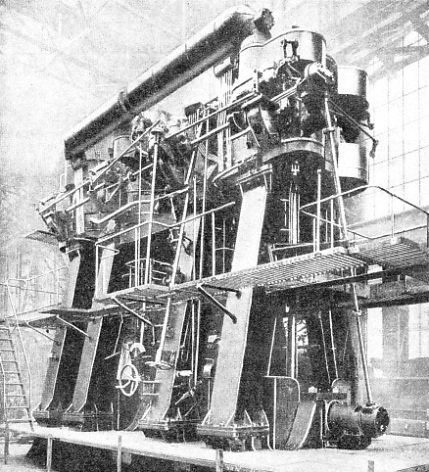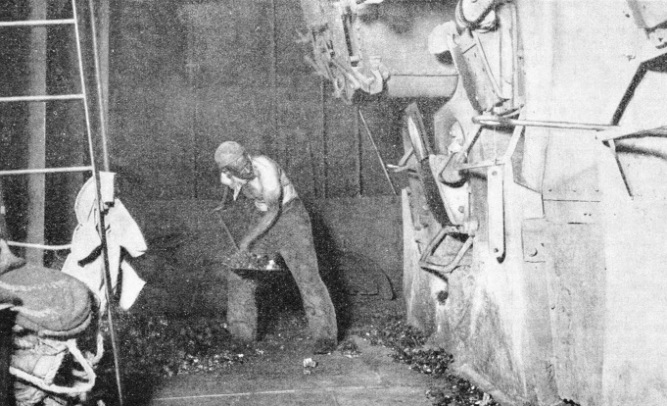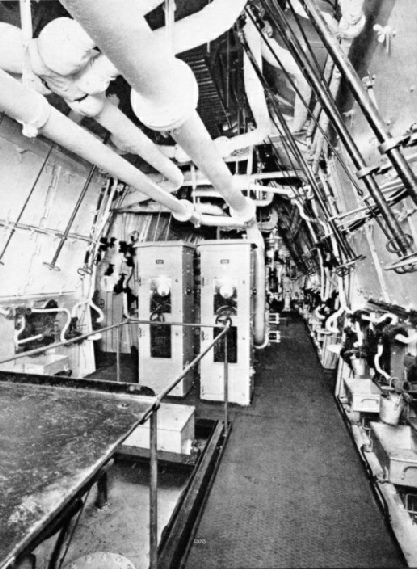

© Shipping Wonders of the World 2012-

The Marine Engineer
An apprenticeship of five years is necessary before a boy is eligible to become a ship’s engineer. Once he has passed his examinations and gained his certificates he has before him many opportunities of self-

PROPELLING MACHINERY of the vast cargo liner City of Barcelona (5,787 tons gross), belonging to Ellerman Lines, Ltd. This vessel has a four-
OF the many branches in which the youngster to-
Although the job of a marine engineer is a good one, the path to it demands the patience which is the traditional attribute of the Scot. It is not a job in which the youngster can go straight from school into the heart of things. Before he can even be considered as a ship’s engineer he has to serve his apprenticeship, the accepted period being five years, in some engineering shop ashore.
The shops or works in which the apprentice serves his time need not necessarily be devoted to marine engineering. The strict regulation of the Board of Trade is that he must have spent three years in the making or repairing of marine engines. This regulation, however, is interpreted generously, and special circumstances are always taken into full consideration, provided that they do not defeat the official purpose of securing the highest professional skill and the greatest possible safety for the ships. A number of budding marine engineers, therefore, begin their apprenticeship in a general engineering works, and many start in the locomotive branch. During his time the apprentice is given the opportunity of seeing as much as he possibly can of the work of an engineering shop. A great part of his time will be spent helping craftsmen of every description and learning as much as he can by watching how they do their work and listening to what they have to say.
After a spell of watching other people, and having been given every opportunity to learn, the apprentice will probably be put in charge of some machine himself -
After the apprentice has completed his third year he will probably be given a good deal of responsible work, for it is generally understood that the last two years of his time are to give his employer a return for the training that he has afforded. By that time the lad ought to be equal to the journeyman. A particularly clever and industrious apprentice will probably spend the last year of his time in the drawing office of the firm. This offers the greatest chance to learn things that are useful for subsequent advancement; but the ordinary apprentice spends only a short time there, just enough to let him understand the work of this department.
When he has completed his time and made up his mind to go to sea, the youngster’s next job is to find a shipowner who will take him. At the present time, when there is a shortage of good marine engineers, there is little difficulty about that, and he has the opportunity of making his choice. For comfort, a big ship is the best, but the ambitious youngster who wants to get his Board of Trade certificate as soon as possible chooses a small ship, for in her he may well be in charge of a watch as fourth engineer; and he cannot sit for his second-

A FIREMAN IN A CARGO SHIP. The old type of coal firing is passing in the big liners with the adoption of oil fuel or mechanical coal stoking, but it survives in many cargo steamers. The work requires considerable skill and is particularly arduous in hot climates. The fireman has to know the exact spot in the furnace where the shovelful of coal should be thrown and the exact amount required. He must keep the boiler furnace fires properly levelled and the fire bars clear of clinkers and other useless products of combustion.
In a big ship the ex-
There are any number of pumps to be watched to make sure that they are functioning perfectly and that there is no fault. The junior engineers are expected also to keep a careful eye on the main bearings in the shaft tunnel to obviate any chance of overheating. They supervise the greasers and firemen at their work and generally look out for trouble in every part of the huge machines. They have to take particular care of the auxiliary machinery, including the generators and steering gear, and in the stokehold of an oil-
Chief Engineer’s Ticket
He must take to the Board of Trade a certificate signed by the Chief Engineer. This will satisfy the examiners as to his ability on the practical side, for the examination itself is entirely theoretical. It is an exceedingly searching one, covering mathematics, a series of written questions and a viva voce examination by a Board of Trade surveyor.
By the strict letter of the law it is only necessary for any ship, even the Queen Mary, to have two certificated engineers, a chief and a second. The bigger companies, however, duplicate all the ranks in the engine-
certificated engineer in charge of the watch has to remain within easy reach of the starting platform all the time he is on duty, the instant and correct obedience of all orders coming through the bridge telegraph being entirely his responsibility. In big ships the senior second engineer does not keep a watch, but the junior second takes the watch from four o’clock to eight o’clock in the morning and afternoon, the senior third engineer the twelve to four watch, and the junior third engineer the eight to twelve watch.
To sit for his chief engineer’s ticket the applicant must have been in charge of a watch with a second-
The most ambitious marine engineers will sit for their extra chief engineer’s certificate, which is exceedingly scientific and which proclaims the holder to be a first-

WATER TUBE BOILERS in the Monarch of Bermuda (22,424 tons gross). There are eight of these boilers, arranged in groups of four, and they supply power to turbo-
The ordinary second-
In addition to these ranks of junior and certificated engineers, there are plenty of other subordinate jobs connected with the machinery of a modern ship, most of which are apt to be something of a blind alley. For instance, the electricians on board are not certificated men, but they must have served their apprenticeship and have obtained practical experience on land. Each is under the engineer in charge of the watch and has all the detail work connected with the electrical side -
Another uncertificated rank is that of the refrigerating engineer, popularly known as the freezer. A big ship carrying fruit, or chilled and frozen meat whose value may run into £1,000,000 sterling, carries several refrigerating engineers who are under the engineer in charge of the watch but responsible to the chief engineer. They have nothing whatever to do with the propelling or the auxiliary machinery, but they are fully occupied with their own work.
The boilermaker, who is usually the only man of his rating in the ship, is generally on day work only, except in emergency. His sole duty is in connexion with the boilers, with which he has been associated since his apprenticeship. He has to see to their cleanliness, upkeep and maintenance, doing all necessary repairs that are within the limits of shipboard work and do not demand the attention of a dockyard. The donkey-
The winchmen are highly skilled men, but there is no necessity for them to have served an apprenticeship. Most big ships carry two winchmen. One of these is on deck, in charge of the winches, windlass and steering gear, but he is concerned only with their maintenance and does not work them at all. The other is the galley winchman who looks after the maintenance of the complicated cooking plant in the galleys, the steam boilers, stoves, and the like. Big ships will carry two plumbers who have already had experience ashore and who are responsible for the elaborate piping of a modern ship, the hot and cold water, the sanitary services, and so on.
Finally there come the firemen, trimmers and greasers. In connexion with the firemen there has been the greatest possible change since the general adoption of oil fuel instead of coal under the boilers of steamers. Only about one-
The old type of coal fireman is passing in the big liners, but he will probably last for many years in the tramps. There are good firemen and bad, and lack of skill will make a surprising difference to the working results of a ship. The good man knows exactly how to make the best use of his muscles, so that he can get through a full watch of hard physical labour without lowering the standard of his work.
The fireman must always keep the burning coal properly levelled. He uses his heavy slices to do this and to keep the fire bars clear of clinkers which would prevent the draught from passing between them. All coal fires have to be cleaned of their ash and clinker once in each watch.
Coal-
The job of marine engineer is not one to be undertaken by the lad who wants an easy time in life and a placid existence with the minimum of effort and work. To the youngster of keenness and ambition, however, it offers magnificent prospects now that shipping is reviving, and there is not the least doubt that these prospects will increase for several years to come. There is a serious shortage of qualified marine engineers, partly because so many have found permanent jobs ashore, and partly because of the severe slump in shipbuilding which caused many big yards to close down or to suspend their activities, thus causing a shortage of apprentices.
You can see a photograph of the forward engine-
You can read more on “Marine Engines and Their Story”, “The Queen Mary’s Engines” and “Steam Turbine Engines”on this website.